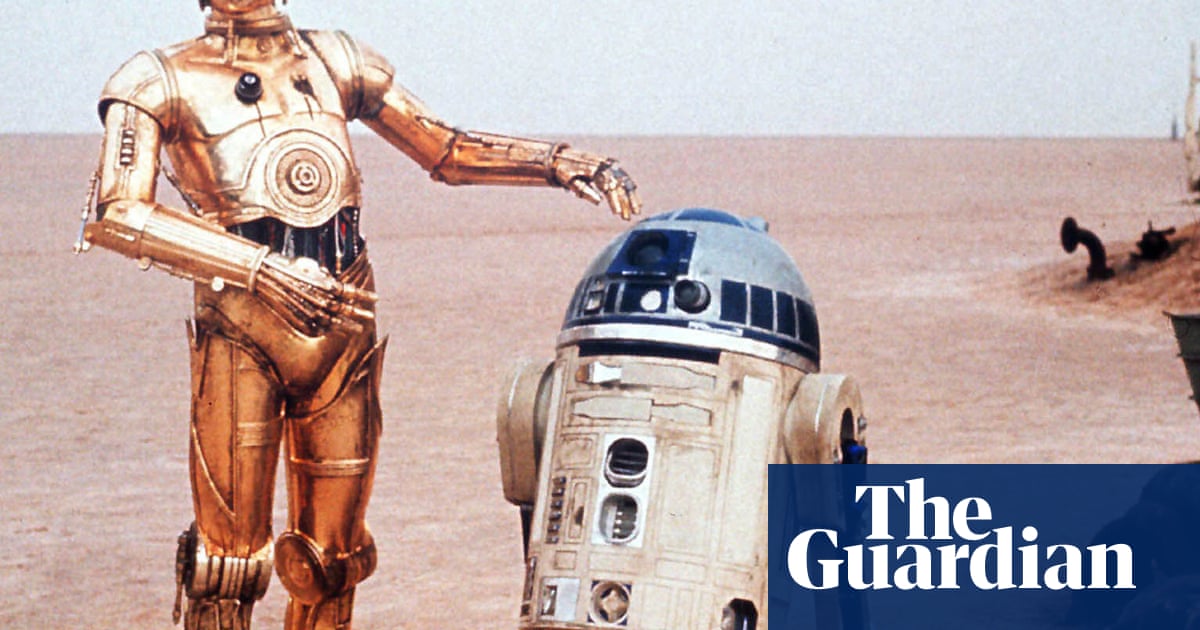Leslie Dilley, who has died aged 84 after suffering from Alzheimer’s disease, won the first of two Oscars as an art director for his work on the original 1977Star Warsfilm. His creation, the much-loved little robotic droid R2-D2, with a silver and blue dome head and rocket boosters that enabled him to fly through space, appeared on screen for more than 40 years (1977-2019), spanning the first three movies and both the prequel and sequel trilogies.
Herecalledthe “head-scratching” challenge in those pre-CGI days. “We started out with a cardboard drum, added cardboard arms and then tried to walk it,” he said. First he built different versions based on conceptual designs drawn byRalph McQuarrie. Then Dilley, along with the director, George Lucas, and John Barry, the production designer on the first movie (which was later retitled Star Wars: Episode IV – A New Hope), decided to go with one that would allow a human – short in stature – to step inside, walk and operate it. “We brought in some actors who we thought would work, but many of them just weren’t strong enough,” Dilley told Star Wars Insider magazine. Eventually,Kenny Bakerauditioned and fitted the role – and the prop.
Dilley was also responsible for the colour and detail of Luke Skywalker’s hovering landspeeder anti-gravity craft, conceived by McQuarrie and the modelmakerColin Cantwell, and for R2-D2’s humanoid robot friend C-3PO, whom McQuarrie based on the female robot from Fritz Lang’s 1927 silent classic Metropolis.
After working on Star Wars: Episode V – The Empire Strikes Back (1980), Dilley won his second Oscar for the firstIndiana Jonesfilm, Raiders of the Lost Ark (1981), directed by Steven Spielberg and starring Harrison Ford as the globetrotting archaeologist.
For the making of one of its best known scenes – Jones fleeing from a South American cave temple with a giant boulder tumbling at his heels – Dilley’s work on set even extended to physical exertion. “I was called upon to help with another bloke to get behind the rolling boulder, pushing it as it chases after Harrison Ford,” he said.
Dilley also worked as an art director on Alien (1979) with the director Ridley Scott. He built sets based on the paintings by the Swiss surrealist artistHR Gigerthat inspired the screenwriter Dan O’Bannon, who jointly wrote the sci-fi horror classic about an extraterrestrial creature stalking and killing the crew of the Nostromo spacecraft. On set for another scene that has gone down in cinema history, Dilley recalled: “When John Hurt’s chest breaks open and we see the baby alien for the first time and blood is spraying everywhere, the actors’ reactions were real – they were caught completely off guard, with blood on their clothing and mouths open in fright and surprise.”
Dilley went on to become a production designer on films that similarly featured fantasy elements. For The Abyss (1989), whose large amount of underwater filming provided special challenges, he and a construction team turned Ron Cobb’s conceptual blueprints for a huge oil-drilling platform into reality – built in a tank of water – as one of the sets in an abandoned nuclear power plant in South Carolina.
For The Exorcist III (1990), he created several illusions, including a large hospital set with all the rooms and areas joined together by hallways, one of them appearing to go on for ever, but actually with consecutively smaller arches and a progressively lower ceiling. “You can create the depth with smaller people at the back,”he said, with a laugh. He also built a “ceiling” on the floor for the filming of a possessed woman crawling along it in the supernatural horror film.
Dilley was born in Pontygwaith, Mid Glamorgan, during the second world war, and grew up in Wembley Park after his parents, Leslie, a chauffeur, and Doreen (nee Willis), returned to their home in Middlesex in 1946. From the age of 15, he studied architecture and building construction at Willesden technical college while on a plastering apprenticeship at the Associated British Picture Corporation.
He did plaster work on the 1963 James Bond film From Russia with Love and worked his way up to become assistant art director on Kelly’s Heroes (1970), The Devils, Macbeth, and The Boy Friend (all 1971) and Jesus Christ Superstar (1973), and an art department draughtsman on another 007 movie, The Man with the Golden Gun (1974). His initial films as art director were The Three Musketeers (1973) and its sequel, The Four Musketeers (1974), and he also took that role on The Last Remake of Beau Geste (1977), Superman (1978), An American Werewolf in London (1981), Eureka (1983), Never Say Never Again (1983) and Legend (1985).
Establishing himself as a production designer, Dilley moved to Los Angeles in 1985. On the Disney comedy sequel Honey, I Blew up the Kid (1992), he was responsible for building two replicas of the family home chosen for filming in California, one of them scaled down 43 per cent for scenes in which the toddler, Adam, appears to be 7ft tall. On that movie and several others, he was also the second unit director.
His last feature film as a production designer wasLittle Man(2006), although he returned to Britain to work on the BBC children’s television series Teacup Travels (2015-17), starring Gemma Jones as Great Aunt Lizzie telling her two grandchildren stories from ancient times.
He received further Oscar nominations, for his art direction onAlien, Star Wars: Episode V – The Empire Strikes Back and The Abyss, and Bafta Cymru’s 2020 outstanding contribution to film and television award.
Dilley is survived by his second wife, Leslie Lykes, whom he married in 1987, and their daughters, Sophia, Ivory and EmmaJane, and son, Leslie; by Georgia, the daughter of his first marriage, to Amanda Parish, which ended in divorce; and by four grandchildren.
Ivor Leslie Dilley, art director and production designer, born 11 January 1941; died 20 May 2025
